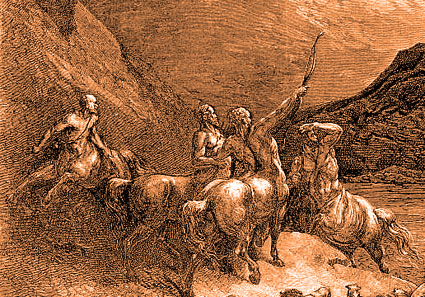I don’t have to convince you that centaurs are amazing. They stroll boldly through thousands of years worth of art, canter through our literary classics and their Photoshopped bodies continue to scandalize the Web. They are of course human/equine hybrids, notable for such qualities as these:
- Much like the Satyr, they often represent the duplicity of man’s bestial and pious nature. That’s why you’ll find them galloping along the banks of a boiling river of blood in Dante’s Inferno, thrusting sinners back to their assigned depths with cruel spears. Elsewhere in the world of sculpture, you’ll find them choking dudes out and punching them in the face.
- Then again, centaurs also pop up in European tradition to represent the “suffering of Christ as the Man and the revenge taken upon his betrayal,” according to monster chronicler Carol Rose.
- If you’re daring, it’s possible to bind an older centaur’s arms behind his back and ride him as your stead. Cupid illustrates this feat on the back of the Louvre’s Old Centaur, which also symbolizes the debilitating side effects of human love. The joyful qualities of love appear are also represented in the younger of the Furietti Centaurs.
- Allegedly inspired by the terrifying sight of Spanish conquistadors on horseback, tales of the Black Devil spread through the peoples of Central America. The creature was said to be a centaur-like humanoid horse clad all in black.
Ah, but what of their biology? Having attended the University of Tennessee at Knoxville some years ago, I’ve seen The Centaur Excavations at Volos countless times. That specimen provides insight into the creature’s skeletal system, but what about all the rest?
Enter Dr. Dr. H.C. Reinhard V. Putz of Germany’s Ludwig Maximilian University Munich Institute of Anatomy (after this unrelated video break).
In his paper Anatomy of the Centaur, available here via the Annals of Improbable Research, explorers just how the skeletal, muscular, nervous, digestive, respiratory, circulatory and reproductive systems might theoretically operate. It’s an amazing collision of scientific and fantastic anatomy, in which we learn such facts as:
- The centaur likely boasted both a primary and secondary heart to pump blood through its hybrid system. All the more reason that the old centaur looks so defeated: he can suffer from two simultaneous broken hearts.
- Within two torsos, the creature also boasts two synchronized diaphragms.
- Even within its equine lower half, the creature would require a human stomach to digest it’s omnivore’s diet of human food.
- While it should come as no surprise to many, the male centaur boasts only a single pair of horsey reproductive glands and a penis “likewise developed according to equine anatomical standards.”
Except, as Reinhard points out, the Cretan variety of centaur (seen here in a mid-8th century B.C. Greek figure) boasts human genitalia between its forward, humanoid legs. Did these creatures pack rear equine genitalia as well? Alas, it remains a mystery.
Reinhard makes no mention of the much-rumored 50 Centaur.
Originally published at HSW: Centaur Anatomy Reveled: Two Hearts, Six Limbs, One Brain
Robert Lamb is a senior staff writer at HowStuffWorks.com and co-host of the Stuff to Blow Your Mind podcast and blog. He is also a regular contributor to Discovery News. Follow him on Twitter @blowthemind.










